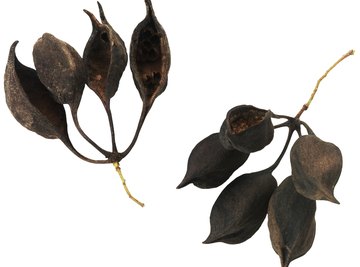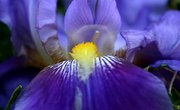
What are five characteristics common to all seed plants? Also called spermatophytes, seed plants have several distinguishing traits. Among the many characteristics of plants that make seeds, the fact that these plants evolved to reproduce without the need for extra water dedicated solely to seed production is most important, according to the Sam Noble Museum.
Many extinct groups and five living groups of spermatophytes exist or have existed, including cycads, ginkgos, conifers, gnetales and angiosperms (flowering plants). Plant examples in these groups include palms, gingko trees, cedars, ephedras and magnolias. There are over 250,000 species of angiosperms alone, making them one of the most diverse phyla on the planet.
Seed Plants Make Pollen
One of the characteristics of plants that make seeds is that they also make pollen - because there can be no seeds without pollen. Pollen grains contain the male sperm of seed plants, which must fertilize an egg in a female spore in order to create a viable seed. All seed plants are heterosporous, which means they make both male and female spores.
Fertilization occurs when a male spore pollinates a female egg. Often, pollen grains are moved by the wind or by insects. Seed plants adapted to live on land by developing this reproductive strategy, thus eliminating the need for water for fertilization of female eggs.
Seeds Are Common to Spermatophytes
Unlike ferns and mosses, spermatophytes produce seeds for reproduction. Characteristics of seeds include providing protection and nourishment for a plant embryo, as well as a way to remain dormant for many years, according to the University of Central Florida. This has allowed the plants an evolutionary advantage in space and time, as seeds can wait in the soil for the ideal conditions for germination.
The production of seeds has helped seed plants to become widespread and successful in many environments, making them one of the most familiar and recognizable groups of plants. Most of the plants grown in gardens and farms are seed plants, including flowering plants like sunflowers, roses, tomatoes, cucumbers and other familiar species.
Vascular Tissue Present
The presence of vascular tissue is another common trait among seed plants. Because most seed plants live on land, they need vascular tissue to move water and nutrients through the plant in order to grow.
Phloem is the name of the vascular tissue in plants that moves food down the plant from the leaves. Water and nutrients are moved up from the roots through the vascular tissue called xylem. Seed plants contain both xylem and phloem to move water, food and nutrients.
Leaves, Stems and Roots
Seed plants generally grow on land and stand upright, making food through the process of photosynthesis. Having structures such as roots, stems and leaves allows them to stay anchored to the ground while spreading out leaves horizontally to capture more sunlight for photosynthesis. Vascular tissues provide structure and stability for seed plants so they can branch out into the world with stems and leaves.
Living on Land
A fifth characteristic of seed plants is that most of them are terrestrial plants - plants that live on land. There are exceptions, but most of the seed plants you're familiar with stay grounded to the earth through roots and rely on the moisture in the soil for most of their water.
Seed plants evolved from mosses and ferns, which rely on water to move their spores for reproduction. Adapting to live on land has meant that seed plants have been able to grow in almost every habitat on the planet, making them a highly diverse and successful group of plants for hundreds of millions of years.
References
About the Author
Meg Schader is a freelance writer and copyeditor. She holds a Bachelor of Science in agriculture from Cornell University and a Master of Professional Studies in environmental studies from SUNY College of Environmental Science and Forestry. Along with freelancing, she also runs a small farm with her family in Central New York.
Photo Credits
Brand X Pictures/Brand X Pictures/Getty Images
